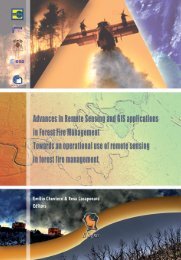EARSeL Newsletter - EARSeL, European Association of Remote ...
EARSeL Newsletter - EARSeL, European Association of Remote ...
EARSeL Newsletter - EARSeL, European Association of Remote ...
Create successful ePaper yourself
Turn your PDF publications into a flip-book with our unique Google optimized e-Paper software.
<strong>EARSeL</strong> <strong>Newsletter</strong> September 2002 - Number 51<br />
24<br />
"we will be able to create maps that highlight<br />
global-scale changes in vegetation<br />
and land cover in response to climate<br />
change, such as drought. We'll also be establishing<br />
the timing <strong>of</strong> seasonal changes in<br />
vegetation, defining when important transitions<br />
take place, such as the onset <strong>of</strong> the<br />
growing season."<br />
Launched on 18th December 1999, Terra is<br />
the flagship <strong>of</strong> the Earth Observing System<br />
series <strong>of</strong> satellites. It is a central part <strong>of</strong><br />
NASA's Earth Science Enterprise, whose<br />
mission is to develop a scientific understanding<br />
<strong>of</strong> the Earth system and its response<br />
to natural and human-induced<br />
changes, to enable improved prediction capability<br />
for climate, weather, and natural<br />
hazards. For more information and images,<br />
see the web-sites earthobservatory.nasa.<br />
gov/Newsroom/LCC and geography.bu.<br />
edu/landcover/index.html. This article is<br />
from a report at www.gsfc.nasa.gov/newsrelease/releases/2002/02-126.htm.<br />
4.10 Ocean eddy mapping by<br />
reflected GPS signals<br />
Just as sunlight glints <strong>of</strong>f the ocean's surface,<br />
so do radio signals from the constellation<br />
<strong>of</strong> global positioning system (GPS)<br />
navigation satellites orbiting Earth. According<br />
to a report on 13th September 2002,<br />
researchers from NASA's Jet Propulsion<br />
Laboratory, Pasadena, California, have<br />
shown that although these reflected signals<br />
are very weak, they can be detected by airborne<br />
instruments and used to map ocean<br />
eddies. Eddies, which affect shoreline<br />
weather and the fishing industry, represent<br />
"one <strong>of</strong> the largest unknowns in Earth's climate<br />
models," said JPL physicist Dr.<br />
Stephen Lowe. Lowe led two aircraft experiments<br />
to test how well GPS could be<br />
used for altimetry, or measuring sea-surface<br />
height.<br />
Eddies are currents that run in a circular<br />
path against the main flow <strong>of</strong> current.<br />
Warm eddies have a higher surface height<br />
than the surrounding water, while cool eddies<br />
are lower. Ranging from 10 to 100 kilometres<br />
in size, many ocean eddies are<br />
either too small or don't last long enough to<br />
be spotted by the current generation <strong>of</strong><br />
satellite ocean altimeters, whose measurements<br />
<strong>of</strong> sea-surface height provide a picture<br />
<strong>of</strong> global circulation. Lowe and his<br />
colleagues aim to determine whether, in<br />
the future, reflected GPS signals could be<br />
used to map small ocean circulation features<br />
such as eddies from space. Co-author<br />
Dr. Yi Chao, a JPL oceanographer, said:<br />
"Eddies are small features with a big impact.<br />
They're where a lot <strong>of</strong> ocean physics<br />
happens, and are an integral part <strong>of</strong> our climate<br />
system. But we don't have enough information<br />
about them to include in our<br />
models. Coastal eddies also have a major<br />
role in regulating the weather near the<br />
shore, and they are important for fisheries<br />
because they're where fish go to feed. In the<br />
open ocean, eddies bring nutrient-rich cold<br />
water up to the surface and are an important<br />
part <strong>of</strong> the global carbon cycle."<br />
In the first experiment, designed to collect<br />
reflected GPS signals from a variety <strong>of</strong> terrain,<br />
the scientists demonstrated that these<br />
signals could be detected and used to calculate<br />
ocean height. In the second experiment,<br />
planned specifically for ocean<br />
altimetry, they showed that their technique<br />
has the potential to provide ocean-height<br />
measurements precise enough to map<br />
ocean eddies. The results <strong>of</strong> the latest experiment<br />
appear in the May 2002 issue <strong>of</strong><br />
Geophysical Research Letters.<br />
Today's satellite ocean altimeters, including<br />
the USA-French Topex / Poseiden and<br />
Jason 1 spacecraft, measure sea-surface<br />
height by sending a radar pulse to the<br />
ocean's surface and timing its return. While<br />
they measure ocean surface topography<br />
very accurately, to within two centimetres,<br />
they see only the swath <strong>of</strong> ocean directly<br />
below, and take ten days to make a complete<br />
map <strong>of</strong> the global ocean. Since an<br />
ocean eddy lasts only a week or two, they<br />
may only catch a portion <strong>of</strong> an eddy's lifespan.<br />
In contrast, an orbiting GPS altimeter<br />
would have no radar, making it relatively<br />
inexpensive. The receiver would obtain position<br />
and timing information from the GPS<br />
satellites, and would measure ocean height<br />
using the arrival time <strong>of</strong> GPS signals reflected<br />
from the surface. At any one time it<br />
would be able to produce about ten simultaneous<br />
measurements across an area thousands<br />
<strong>of</strong> kilometres wide. A constellation <strong>of</strong>
















